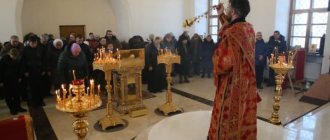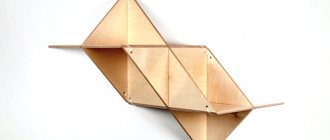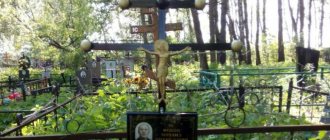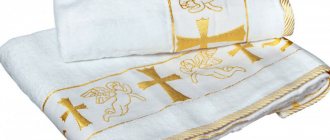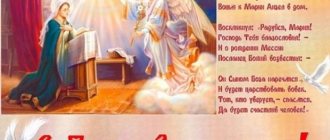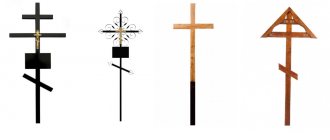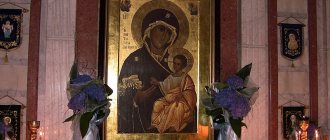An icon case is a special design for an icon, which in appearance resembles a wooden box. It is designed to protect the image from mechanical influences, changes in temperature and humidity, drafts, candle soot and other negative factors. Properly created conditions make it possible to preserve the icon for many years, make it a family heirloom, and pass it on to inheritance.
In addition, a carved wooden icon will fit perfectly into any interior and decorate a temple, chapel, or home.
Where can I get an icon case? There are several options: the simplest and most convenient is to order its production from specialists or buy a ready-made version. More labor-intensive, but economical - to do it yourself.
If you are not looking for easy ways and have golden hands, then choose the second option. In this article we will tell you how to make the simplest icon case with your own hands.
History of icon cases
The icon case is needed in order to preserve the painting of unique icons. Previously, the relics of saints and Tablets were kept in icon cases; now they are used to protect especially valuable images from dust, mechanical damage, and direct sunlight.
Interesting to know! During the Middle Ages, the icon case began to be valued as decoration. Famous masters turned icon storage boxes into real works of art. Since then, the icon case has become an integral part of the church.
Making an icon case with your own hands 01/26/2022
Today, many homes of Orthodox families have icons. The choice of icons is an extremely individual matter; believers choose them by listening to the voice of their hearts. In Orthodoxy, there is no strict regulation of the order of placement of icons in a home, but traditionally icons are placed on the eastern side of the house - they are hung, placed on shelves and quite often placed in beautiful wooden icon cases.
rice.
1 Icon in an icon case What is an icon case, and why is it needed?
Essentially, an icon case is a kind of cabinet designed to store an icon. It performs a specific function - it protects the icon from dirt, dust, and various types of mechanical damage. It is thanks to the icon case that the faces of saints on the icons are perfectly preserved in a special microclimate: 1. Icons standing in icon cases are less susceptible to the negative influence of changes in air temperature and humidity (this is not uncommon even in modern homes);
2. The icon case protects from drafts, direct sunlight, and droplets of moisture that accidentally fall on the icon;
3. An icon standing in an icon case is not so afraid even if it is close to a heater, air conditioner or central heating radiator.
You can, of course, simply buy wooden icon cases, but it is much more interesting to make an icon case with your own hands. Created with warmth and love, it will charge the icons with special, spiritual warmth, especially if an old family icon is stored in it.
rice. 2 Icons can vary greatly in appearance
Materials and tools
Most often, icon cases are made, in accordance with the recommendations of experienced icon restorers, from well-dried wood, most often from beech or pine.
To make icon cases, the craftsman will need the following materials: 1. planks for the box (beech, pine); 2. two types of glue – acrylic and rubber; 3. baguette, hardboard, cord; 4. sealant; 5. iron and brass nails; 6. hinges, suspension, box-type clasp 7. glass.
rice. 3 Pine is a popular choice of wood for icon cases
In addition to materials, tools will also come in handy. There should be no problems with them; you will need standard tools; every man who at least occasionally makes something will probably have them. So, to make icon cases with your own hands, you will need the following tools:
1. Miter box (special emphasis for correct sawing of planks, at the desired angle); 2. A hacksaw with a fairly fine tooth (high-quality tenon hacksaws are ideal); 3. The most common simple pencil, ruler and tape measure; 4. Clamps - special clamps with which the master will fasten the planks on a work table or in a miter box in order to cut the planks efficiently, without distortions; 5. A ruler-corner made of metal, it will be convenient to mark cuts at the required angles, as well as measure the dimensions of the parts of the icon case; 6. You also can’t do without pliers and a side cutter; 7. You will also need a screwdriver, Phillips or universal, with a set of interchangeable tips; 8. Sandpaper (fine) and a special holder for it will also come in handy; 9. Electric drill with a set of drills; 10. Gun for sealant (it will be used to fix the glass); 11. Elastic spatula; 12. Knife with a set of replaceable blades; 13. Brushes for painting the icon case with stain, varnish or oil.
rice.
4 Prepare tools for woodworking Making icon cases for icons - main steps Step 1.
At the very beginning, you need to create the correct drawing of the future icon case. For the drawing, it is necessary to measure the width and height of the existing icon, as well as the thickness of the wooden board and the height of its deflection (antique icons often bend). If, say, the distance from the table surface to the bending point is 40 mm, then for the side of the drawer you will need slats with a section of 15 by 45 mm. It is important to draw up the drawing so that the icon is not cramped inside the finished icon case.
Step. 2
Finished wooden planks must be cut into the required sizes, according to the length and width of the sketch. It is important to cut the boards strictly at right angles.
Step. 3
On the sidewalls, along the edges, you need to make markings using a square, adding 1 mm to the thickness of the board. Next, using a hacksaw with fine teeth, cuts are made on the sides of the icon case; it is important not to cut 5 mm to the edge.
Step. 4
At the next stage, you need to take a sharp knife, place it at the end of the boards, and peel off a quarter of the wood, tapping the knife with a hammer. If it is chipped unevenly, it must be carefully trimmed.
rice. 5 Making an icon case yourself requires some skill Step.
5 Next, on a flat table you need to assemble the entire box of the icon case, fitting it with clamps. The joints should be coated with glue. It is important to correctly align the edges of the box joints and tighten the clamp nuts well and evenly. If the glue has come out, you can remove it with a slightly damp cloth.
Step. 6
Using a square, you need to check the internal corners of the icon case and correct any irregularities. The box should be left to dry for 10-12 hours.
Step. 7
After this time, you can start sanding; you can sand it with a sanding machine or sandpaper. Next, you need to trim the edges of the box with a plane.
Step. 8
Next, you will need to draw lines on the bottom and top sides of the box, as well as on the sides, 20 mm from the edge, for the future door. You need to carefully saw off the frame according to the markings.
Step. 9
Then, from hardboard, the back wall of the box is cut out, 5 mm less than the front perimeter, on each side.
Step. 10
Then the frame is placed with the sawn part on a flat table, and a wooden layout is taken (width 30 mm, thickness 5 mm). One side of the layout is sawed off into a miter box using a hacksaw at an angle of 45 degrees. Now the length of the side of the layout is marked, and its second corner is sawed off.
rice.
6 The icon case can be quite simple in shape . Step. eleven
The sides of the frame are smeared with glue, the layouts are applied to them and tightened. Now you need to adjust the next corner of the layout; there should be no gaps at the junction. Thus, the layout is completely glued.
Step. 12
Next, the door needs to be sanded and the hinges installed. Hangers are placed on the dried box, a hardboard back wall is nailed, and glass is inserted into the door. The glass is fixed with a reliable sealant. Wood putty can also be useful during the work process - it perfectly hides flaws in the wood. It can, for example, mask the joints of parts and other unforeseen defects. Wood putty is now sold in different colors, it makes sense to choose a domestic one, it is inexpensive and very economical!
You can watch the process of making a carved icon case for a specific icon in the following video:
Accessories for icon cases and surface treatment
Everyone makes the design according to their own taste; today, accessories for icon cases are sold in a wide variety. Properly selected fittings give the icon case a finished look and functionality. For the icon case you will need the following fittings: miniature hinges (for fastening the door), a “box” clasp, a special pendant ring, miniature iron nails and small brass nails for attaching the clasp, a decorative patch lock (optional).
rice.
7 When making an icon case, you will need accessories. To tint the icon case, you can use either a high-quality alcohol-based stain or a protective, colored oil. The second option is preferable, because the oil will work both as a tinting material and as a finishing material. To add shine and additional protection, the icon case is coated with varnish.
rice. 8 You can decorate the surface of the icon case with carvings
How to make a homemade icon case with your own hands
An icon case can be made at home, as it has a fairly simple design. In essence, it is a simple wooden box with a front wall made of transparent material - glass.
Floor icon case
In order to make a good icon case, it is recommended to take measurements and make a drawing. According to the existing drawing, a frame is made from boards.
Attention! To make an icon case, it is recommended to use pine, birch or oak.
The glued and dried frame is treated with sandpaper. The front door of the icon case consists of a frame and glass. The frame is attached to the frame of the icon case using fittings, the glass is fixed with sealant. At the final stage, the icon case is varnished or treated with stain.
Tools and materials for making an icon case:
First you need to prepare certain materials and tools for the job.
Sample set of tools:
- wood hacksaw with fine teeth;
- miter box - a special device for cutting material at an angle;
- clamps - clamps for fixing parts during processing;
- metal ruler in the form of a corner;
- a screwdriver, a universal one with replaceable bits is better;
- pliers and side cutters;
- emery cloth or abrasive mesh;
- clip-holder for skins;
- electric drill and set of drills for wood and metal;
- hammer;
- sealant gun;
- large knife with replaceable blades;
- elastic spatula;
- brushes for coating the product with oil, varnish or stain.
Approximate list of materials:
- frame of the icon case made of wood (the easiest way is to buy a ready-made baguette);
- wooden slats for the side walls of the icon case;
- a backdrop for which both plywood and hardboard are suitable;
- fittings, you will need nails and screws of different types, hinges for attaching the door and a fastener;
- cord for laying between the door and the drawer itself;
- glue for wooden parts and cord fastening;
- wood putty;
- sealant;
- glass;
- oil, varnish or stain to coat the finished product.
Design options
Icons can be homemade
and
temple
,
wall
,
floor
,
lectern
and
tabletop
.
They may contain one or more icons. Sometimes the icon case is built into the iconostasis. Column icon
cases are those built near the columns of the temple.
Depending on the size of the image and its location (at home or in a temple), the icon case can be either very small or grandiose, exceeding human height.
icon cases in temples
with
a canopy
- a special canopy or decorative roof, with steps leading to it - in fact, such an icon case becomes a kind of chapel inside the temple, it creates a special prayer space for the image (images) contained in it. Such solid designs are usually used to distinguish revered, miraculous icons.
Nowadays, icon cases are created in which a special humidity and temperature regime is maintained to ensure the safety of the icon. As a rule, images that are works of art are placed in such icon cases. There are also icon cases with bulletproof glass.
Helpful advice
When purchasing an icon case, you should ensure that it contributes to the preservation of the icon and in no way harms it. To do this, you need to provide a number of parameters.
• The icon in the icon case must be securely fixed. In this case, the image should stand freely enough so that nothing deforms it.
• There must be sufficient space between the glass of the icon case and the surface of the icon.
• The lid of the icon case must close securely. If the icon case will be located in a temple or other public building, a quality lock should probably be provided.
Drawings of icon cases
Before designing the icon cases ourselves, we studied many old icon cases, visiting museums and doing restoration.
We took a lot of measurements. Based on them, drawings were made. Trying to understand the proportions and principles of architectural construction, we compared the proportions of the icon cases with the principle of constructing porticos and discovered a lot of interesting things. There are icon cases designed by architects according to the principles of orders. There are those that are built, at first glance, chaotically, and there are those that are made as the manufacturer wanted.
There is nothing to say about architectural ones; it is enough to study architecture textbooks with a single amendment. There is practically not a single building or object that was made according to the rules “literally”. The following can be said about those that were made at the discretion of the master. Most of the surviving icon cases are the result of folk crafts. Among them there are very interesting and beautiful icon cases. They can be repeated or made similar to them, but these icon cases cannot be designed using any rules. Because they don't exist. They were made at the craftsman's level. You start making such products after you have gained many years of experience. Over time, we will try to expand on this topic in more detail.
The most difficult thing for a modern architect is to design in the old Russian style or in any eclecticism, especially Russian. Most modern icon cases and iconostases have awkward shapes. The harmony of almost most modern products and buildings has been disrupted. Houses, temples, icon cases, church and household utensils have very modest achievements. Most modern buildings are temporary. Nobody builds to last a hundred or two hundred years or more. One can only regret modern concepts of beauty. The same applies to household utensils: there is no beauty - laminate, chipboard, MDF and other rubbish. Furniture from industrial waste. Compare this furniture with any merchant's table. What a difference! In order to erase this difference, we need to remember the best house building rules that our great-grandfathers adhered to. Every ruble should be spent wisely on an item that is reliable, beautiful and will last you and your relatives for many years. The house is reliable and durable, the roof of which will not be blown away by the wind. Of course, it's not all bad. And today masterpieces are born. And today there are architects who can be awarded the title “ARCHITECT”. But the modern weakness of architects lies in the modesty of education. Or to be more precise, in his absence. There are simply no textbooks on temple construction and, accordingly, the design of iconostases, icon cases and church utensils. There is no textbook that would tell us about Russian eclecticism. To fill the gaps, it is necessary to educate yourself, take projects as a basis, and consult with more experienced people. But above all, have faith in yourself. Attend general services and liturgy. It is necessary to know the liturgy, since everything in the temple is connected by liturgy and service.
There are open questions for us, but most of the answers have been received thanks to our older brothers. Unfortunately, their work was interrupted by their death. We will try to continue our work and share the results with those who are interested.
Over time, we developed the following method for designing icon cases. For example, you need to design an icon case in the Russian eclectic style for a 19th century church. First, we study the features of the style and history of the temple. In the archives we look for stylistic variations, features and techniques. We get ready to work and... Most often, the result is positive. Because we always trust in Him to whom we go.
Types of icon cases with photos
The type, size and manufacturing features of the frame depend on the icon for which it is being prepared. Usually, icon cases are made for a specific image, taking into account its size.
Wall mounted
In most cases, icon cases are made of wood, most often oak, pine and birch. There are products made of metal, glass and plastic.
Designs intended for placement on the wall can be of different shapes and sizes, with or without decoration, with or without glass, with a special hinged door, for one or more images. At the back they are equipped with a special mount that allows you to place them on the wall. Wooden wall icon cases are used in churches and residential buildings.
Floor-standing
In icon cases of this type, large icons are usually placed, but not necessarily human-sized. In this case, the cabinet has a powerful base and can be supplemented with a candlestick. The design and shape can be anything, as well as the execution style. Such caskets are placed in churches or on the street.
carved
Carving can be called the most suitable way to decorate holy icons. Carved frames and intricate patterns are used on the floor icon cases at the top, around the image and below on the base.
Carved design decorates, accentuates attention, but does not interfere or distract.
Wall mounted
Floor-standing
carved
Direct
The most common type of chests for icons are simple rectangles or squares. There may be some corner smoothing and glazing, but no carving. Similar products can be found more often in homes. They are usually small and easy to transport.
Arched
The shape of an icon is not always rectangular. Therefore, the frames for them are made in accordance with the features of the image. Arched caskets are often made to decorate dimensional images depicting the saint in whose name the baby is baptized.
Curly
The standard form of the icon case can be supplemented in the upper part with a decorative figured crown. The designs are made in different ways: simple with wavy lines or ornate, complex patterns with carvings.
Direct
Arched
Curly
From the history
Like iconostases, icon cases were created in artistic styles that were preferred in society in different eras. Many icon cases in the Baroque style have come down to us, there are examples of classicism, and the icon cases created by the masters of Russian Art Nouveau delight the eye and surprise with their fresh solutions. However, they all have certain common features that have passed from century to century.
A special phenomenon can be called icon cases created in the Russian North. They represented a single composition consisting of an image and its frame. It could be not only an icon, but also, for example, a semi-volume figure of St. carved on wood. Nicholas the Wonderworker. There were triptych and folding icon cases: the central image is complemented by closing doors on which images of saints are written. Finally, a carved composition consisting of the instruments of the Passion of Christ could be built into the icon case: Cross, spear, sponge, crown of thorns, etc.
Manufacturing stages:
Stage 1. Preparatory:
Before starting work, you should decide on the size of the icon case and make a drawing. It must be taken into account that due to uneven drying of paint and wood, the icon can change its size, geometric shape, and become deformed. It is important to think through the drawing in such a way as to provide sufficient space for the holy image and leave gaps.
Stage 2. Manufacturing of the icon box:
Next, you need to build the base of the icon case, which consists of four planks. Cut out the bars of the required size and sand the edges. We fasten the resulting parts together using self-tapping screws, and apply wood glue at the point of contact of the bars. To give the product a more aesthetic appearance, you can treat the joints with wood putty.
Stage 3. Making the backdrop:
Cut out a rectangle for the backdrop. We take into account that the back part must be made 2-3 mm smaller than the outer contour of the product, this will help hide the protruding edges and give the creation a more neat look. We nail the backdrop to the icon case using small nails.
Stage 4. Door frame:
The frame is the front part, which must be done extremely carefully, since the slightest flaws will be immediately visible. It is best to make a frame that is slightly larger in size than the icon box. This solution will help hide the inevitable flaws of handmade work, such as unsightly joints.
If you bought a baguette, then you need to cut it exactly at 45 degrees; a miter box will do the best job with this task. We glue the finished parts together and, if necessary, cover the defects with putty.
Stage 5. Assembly:
Assembly is the most exciting stage. We place the hinges with one side to the icon box, and the other to the frame. Install a miniature fastener. Don't forget to glue the cord under the door, it acts as a seal.
Stage 6. Glass:
When the frame is ready, you can safely cut out the glass part. Place the washed and dry glass in the frame and secure it with sealant.
Stage 7. Trying on:
If the icon does not hold well enough in its house, then you can fix it with ordinary cardboard. In many antique icon cases and in custom-made products, a special internal frame is provided for these purposes.
Decor features
An icon case is a significant element of decoration of a temple or home holy corner. Temple icon case
can be an independent work of church art or repeat the artistic design of the iconostasis.
Framing the icon, the icon case serves as its decoration. In accordance with this, icon cases are usually carefully decorated: covered with carvings, sometimes with painting, and often complemented with basma inserts.
If an icon is a “window to the Heavenly World,” then the icon case is its frame. Therefore, many icon cases
in their structure and appearance they resemble intricately decorated window frames. Another meaning of an icon case is a house for an icon. Therefore, in a significant part of the icon cases we can see the “roof”, “walls”, “base”. Often the icon case formed a common composition with the chasuble of the icon.

